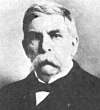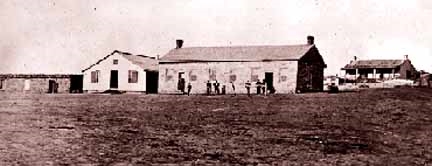(from Early Ford County, by Ida Ellen Rath, 1964, FCHS, All Rights Reserved)

Fort Dodge [named for Brigadier General Grenville M. Dodge] was one of the most important forts on the western frontier. It was located to the east of the Caches and [present] Dodge City site in 1864, being an old camping ground for wagon trains going to New Mexico.
A Colorado regiment [under Colonel James H. Ford] was camped there before the establishment of the fort, which lay on the north bank of the Arkansas River and was in the shape of a half circle. Close to the river was a clay bank about twelve feet high. There the soldiers were quartered in dugouts with port-holes all around. [According to the Dodge City Daily Globe, Sept. 10, 1930, “Seventy of these, each ten by twelve feet, were sunk in the river bank to a depth of four to five feet…. By 1870, wooden bunks were provided.”] The officers were quartered in sod houses inside the enclosure. It was a four company post and in later years the government had ten men and a sargeant stationed at Robert Wright’s ranch on escort duty to protect the mail. On the east side of the Fort Dodge enclosure was a large gate. [The fort opened in 1865.]
The need for a fort at this location was great; an unusually large camp site for the fort was situated where the dry route and the wet route [of the Santa Fe Trail]… intersected. The dry route came across the divide from Larned on the Pawnee [river], while the wet route followed the river…. The dry route, often called the Hornado de Muerti, the journey of death, was often without water the whole distance and trains would lay up to recruit after making the passage, which caused that point on the Arkansas River to become a great camping site. When the Indians found this out, they made it one of their haunts to pounce down on the unwary emigrant and freighter.
…General [Philip H.] Sheridan first came to Fort Dodge in the summer of 1868. He pitched his camp on the hill north of the fort and started fitting out his command against the Indians. The last visit General Sheridan made to the fort was in 1872 and he brought his whole staff with him…
In the fall of 1868, General Alfred Sully took command at the fort and fitted out an expedition for a winter campaign against the plains Indians. When the preparations for the expedition were well under way and his army practically ready to march, General…Sully was sent home and General [George A.] Custer carried on the campaign.
The abandonment of Fort Dodge in June, 1882, created surprise among the Dodge City people generally and they feared Indian raids. The troops stationed at Fort Dodge were sent, one company each to Fort Reno, Fort Supply, and to Fort Elliott, Texas, where they could be near the Indian reservation.
After its abandonment, part of the buildings were demolished, some removed. Later when rebuilding and repairing began and the establishment of the Soldiers’ Home became a reality, the character of the famous old post was sustained. Many of the old battle-scarred stone buildings are yet in use, situated in beautifully landscaped grounds. …A resolution was introduced in the Kansas legislature [by George M. Hoover] asking congress to cede the Fort Dodge military reservation for the Soldiers’ Home….[On March 2, 1889, Congress passed an act authorizing the land transfer. It opened January 1, 1890.]
… May [31], 1886, a sudden rush for settlement, on Fort Dodge [12,000 acres] reservation was made, early one Monday morning, and a hundred claims were staked off, between Sunday midnight and Monday morning before sunrise. No one seemed to know how the reservation was thrown upon the market all of a sudden and no one stopped to inquire but went right along with settling and improving some portion of the reservation, regardless of what the outcome might be. In fact, people were perfectly wild with excitement occasioned by this mysterious move. But the land was really opened to settlement, on terms prescribed by the government, by purchase and priority in settlement.
[Ida Ellen Rath, was the daughter-in-law of Charles Rath, early buffalo hunter and pioneer. Much of this excerpt was adapted by Rath from Robert Wright’s Dodge City, The Cowboy Capital, 1913, still the best book on the period.]
(© 2002, Ford County Historical Society, Inc., Rath Collection)

